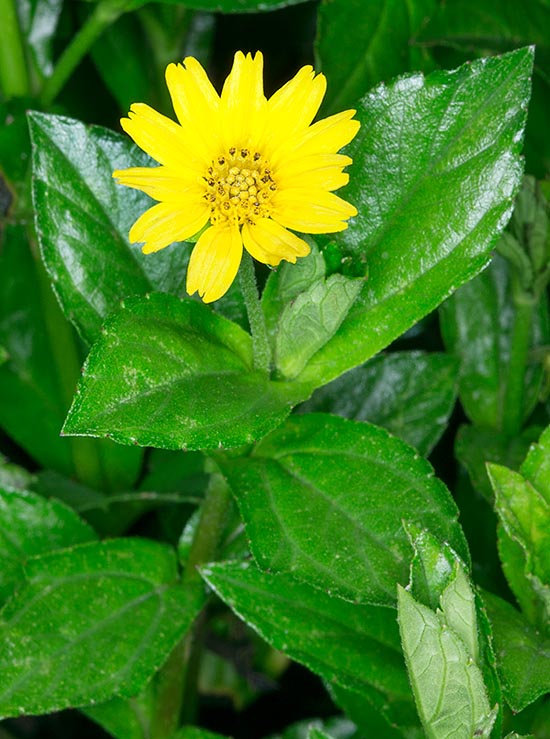Family : Asteraceae

Text © Pietro Puccio

English translation by Mario Beltramini

As the generic name states Sphagneticola trilobata is a tropical America plant loving the humid soils. The traditional medicine and laboratory studies have shown in the extracts of the leaves the presence of compounds with analgesic, antibacterial and anti-inflammatory activity © G. Mazza
The species is native to Belize, Brazil, Colombia, Costa Rica, Ecuador, French Guyana, Guatemala, Guyana, Honduras, Mexico (Campeche, Chiapas, Quintana Roo, Tabasco and Veracruz), Nicaragua, Panama, Peru, St. Lucia, Surinam and Venezuela where it usually grows on humid soils and along the beaches, at low and medium altitudes.
The generic name comes from Sphagnum, kind of moss, and from the Latin verb “colo” = to live, with obvious reference; the specific name is the Latin adjective “trilobatus, a, um” = trilobed, with reference to the leaves.
Common names: creeping daisy, creeping oxeye, gold cup, Singapore daisy, Spanish verveine, wedelia, wild marigold, wild sunflower (English); pasmo (Belize); agrião, insulina, margaridão, picão-da-praia, vedélia (Brazil); clevellin de playa (Costa Rica); romero de playa (Cuba); margarita (Guatemala); kan kun, siemprevive, taj (Mexico); me caso no me caso (Nicaragua); clavellín de playa, flor de coco (Panama); manzanilla, manzanilla de playa, margarita amarilla (Puerto Rico).
The Sphagneticola trilobata (L.) Pruski (1996) is a perennial herbaceous species, procumbent, vigorous, ramified, 15-30 cm tall, with cylindrical stems, 10-40 cm long, green or reddish, rooting at the nodes. The leaves, sessile or on a short petiole, are opposite, trilobed to elliptic-lanceolate with pointed apex and irregularly serrate margins, quite thick, 5-10 cm long and 1-5 cm broad, of intense green colour, glossy and wrinkly to the touch. The inflorescences, on a 5-20 cm long erect peduncle, are the typical capitula of the Asteraceae, solitary, axillar, formed by numerous sessile flowers spirally inserted on a roundish base, the receptacle, of 4-6 mm of diameter, surrounded by an involucre formed by a series of lanceolate bracts with ciliated margins, 1-1,5 cm long, of green colour. The flowers of the outer ring, called ray flowers, fertile, in number of 8-13, 0,6-1,5 cm long, have the corolla ovate with usually tridentate apex, of bright yellow colour. The disk flowers have tubular corolla, 4-5 mm long, yellow. The fruist are achenes, (or, more precisely, cypselae) clavate, about 5 mm long, of blackish colour, provided of pappus formed by a crown of irregularly merged scales.
It reproduces by seed, but usually and easily by division and stem portions.
Fast growing species with ornamental foliage and blooming almost continuously in the tropical and subtropical regions, utilizable also in those with warm temperate climate, where it can resist to temperatures just a little under the 0 °C, losing the aerial part, but regrowing in spring. Particularly suitable as soil cover in full sun, for an abundant blooming, but adapts also to poorly luminous situations; utilizable in the control of the erosion and in the stabilization of dunes. Conversely, it reveals highly infestant as easily escaping cultivation, also through small fragments of stem, and colonizing rapidly ample spaces forming a compact mass of vegetation that suffocates the previously existing vegetation, is able to cover, climbing, also shrubs and small trees. In fact, it adapts to an ample variety of soils, humid, preferably, but also droughty, stony to sandy, acidic to alkaline, bears even high levels of saltiness.
Parts of the plant are utilized in the traditional medicine for various pathologies, laboratory studies have evidenced in the extracts of the leaves the presence of compounds having analgesic, antibacterial and anti-inflammatory activity.
Synonyms: Silphium trilobatum L. (1759); Buphthalmum repens Lam. (1785); Wedelia carnosa Rich. (1807); Polymnia carnosa (Rich.) Poir. (1816); Polymnia crenata (Rich.) Poir. (1816); Buphthalmum procumbens Desf. ex Steud. (1821); Buphthalmum strigosum Spreng. (1821); Acmella spilanthoides Cass. (1822); Acmella brasiliensis Spreng. (1826); Wedelia paludosa DC. (1836); Wedelia paludosa var. vialis DC. (1836); Verbesina tridentata Spreng. (1826); Wedelia paludicola Poepp. (1843); Verbesina carnosa (Rich.) M.Gómez (1890); Seruneum trilobatum (L.) Kuntze (1891); Wedelia trilobata (L.) Hitchc. (1893); Stemmodontia carnosa (Rich.) O.F.Cook & G.N.Collins (1903); Wedelia brasiliensis (Spreng.) S.F.Blake (1930); Complaya trilobata (L.) Strother (1991); Thelechitonia trilobata (L.) H.Rob. & Cuatrec. (1992).
→ To appreciate the biodiversity within ASTERACEAE family please click here.
